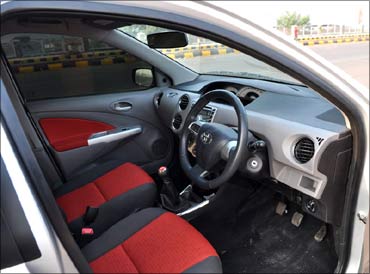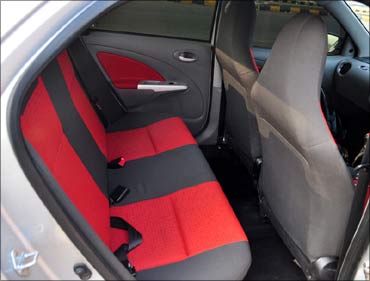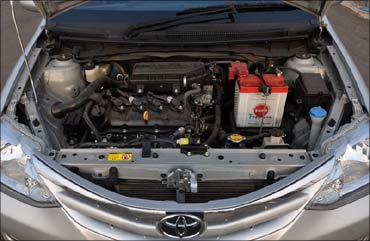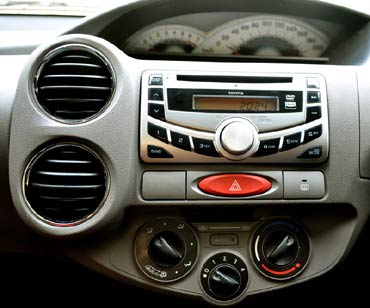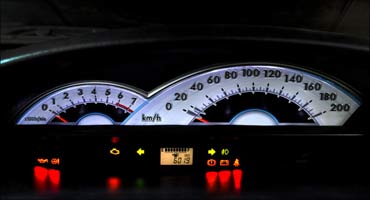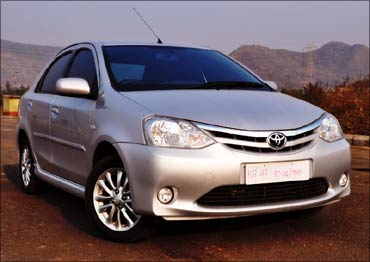 | « Back to article | Print this article |
Road test: Toyota Etios clears with flying colours!
Toyota, one of the world's largest car makers, spent over five years to design a car which could favour Indian conditions and clientele alike.
After over 200,000 km of testing in various Indian conditions, the Etios was launched on December 1, 2010. This is Toyota's first major product for India, designed for the emerging economies of the world.
We got the first glimpse of the Etios at the 2010 Auto Expo held in New Delhi, when Toyota unveiled the sedan and the hatchback version to the world.
This car has been propositioned to help Toyota penetrate deeper into the Indian car market and maybe even become segment leader.
So, how impressive is the Toyota Etios? We find out as we drive one.
Click NEXT to read on . . .
Road test: Toyota Etios passes with flying colours!
The Etios is based on Toyota's EFC platform (Emerging Market Frontier Concept) and is Toyota's first low-cost car for India.
The Etios may not be drool-worthy, but it does sport a basic yet efficient design. The front grille of the Etios resembles that of the Innova and it looks well-integrated with the headlamps.
The simple hood and bumper design, and the chrome lip (which goes missing on the base model) make the smiling grille more prominent.
The silhouette of the Etios doesn't sport any sharp crease lines, it is rather simple with flanged arches and the door handle and rubber strip get some chrome treatment on the top-of-the-line VX trim.
Click NEXT to read on . . .
Road test: Toyota Etios passes with flying colours!
The blacked-out B-pillar, the shallow greenhouse area and the 15-inch alloys are a saving grace. The rear end of the Etios does gel well with the boot and doesn't feel like an afterthought unlike its main competition -- the Maruti Suzuki Swift DZire.
As the sedan has been launched in India alone, it hasn't gone through the EuroNCAP or NHTSA crash tests.
The engineers at Toyota wanted to design a sedan for a family that can only afford a single car, so by default the Etios had to be spacious.
The Etios can comfortably seat five adults and to make things easier the central tunnel has almost been flattened. The interiors are designed ergonomically, but we wish the fit and finish of the overall plastic quality could have been better.
Click NEXT to read on . . .
Road test: Toyota Etios passes with flying colours!
Get inside the Etios VX and you will be welcomed by black and red upholstery and of course loads of space. The steering wheel of the Etios is sporty and the VX variants gets audio-controls mounted on the steering wheel. The instrument cluster is at the centre and this helps bring down production costs.
The top-of-the-line VX trim gets an in-dash 2-DIN DVD player while the V variant gets a 2-DIN mp3 player, the other misses out on the system. The music played through the four speakers is decent and considering the ad campaign we expected some A.R. Rahman CDs with our press demonstrator.
The slim A-pillar increases the front visibility and the location of the central instrument cluster doesn't block your vision. The driving position is great and the light steering makes manoeuvring in city convenient. To our dismay, the mirror adjustment even on the top-of-the-line trim is manual.
The Etios on the inside is very practical as it gets a 13-litre glove box and incorporates an AC vent to keep things temperature controlled.
Click NEXT to read on . . .
Road test: Toyota Etios passes with flying colours!
The seven cup holders can easily fit a one litre bottle each. The large boot of the Etios can swallow up to 595 litres of luggage. Talking about safety, two airbags come as standard on the V and VX trim level and is available as an option on the G variant.
Engine
Toyota has stocked the new 2NR-FE 1.5-litre engine in the Etios -- the first Toyota to get this engine. This 1496cc motor churns out 89bhp@5600rpm and a maximum torque of 132Nm@3000rpm.
The 2NR-FE engines for other car markets will get variable valve timing (VVTi in Toyota's speak) only for the intake, but the Indian spec gets a double camshaft without the VVTi to keep the cost low.
But here the entire game changer is the power to weight ratio of the Etios which is more than 90bhp/tonne.
Click NEXT to read on . . .
Road test: Toyota Etios passes with flying colours!
The Etios is very light as it has a kerb weight of 930kg, this makes it lighter than most of the B+ hatchbacks like the Volkswagen Polo, Fiat Grande Punto, Maruti Suzuki Swift, Hyundai i20, Ford Figo to name a few.
The engine is nippy and power is always available at the tap of your right foot. This motor happily revs upto 6000rpm, but it tends to get a bit noisy when it crosses the 3500rpm mark. The torque spread is good and the power delivery is linear like any other efficient petrol engine.
In our performance run, the Etios galloped to 100 kph in 11.9 seconds and completed the quarter mile in 18.1 seconds.
Click NEXT to read on . . .
Road test: Toyota Etios passes with flying colours!
Drivetrain
Most of the sedans producing 90bhp or less face the problem of not being very drivable in the city as the power only comes in the latter half of the rev band.
Toyota has done its homework well, the gearing is good enough for city and highway driving!
The gear lever is small and the shifts are precise. The round red knob (it's red only on the VX trim!) is short and easy to engage.
In our in-gear test, the Etios clocked the 30-50kph run in 4.0 seconds in the third gear and 5.9 seconds in the fourth; the 50-70kph run in the fifth gear took 7.3 seconds. These figures are remarkable for a 90bhp petrol sedan.
Click NEXT to read on . . .
Road test: Toyota Etios passes with flying colours!
Fuel economy
The Etios returned us with a best figure of 16.87kpl and it's overall fuel economy is of about 11kpl with mostly city driving. In our performance test, we got the worst figure of 9.54kpl, which is all pedal-to-metal driving.
The Toyota Etios gets struts upfront and the rear anchors torsion beam. The suspension set-up is soft to ensure a better ride and decent handling.
The Etios smoothly glides over potholes with a thud noise and most of the road shocks do not get filtered into the cabin. The ride is smooth, but some road noise does intrude the cabin.
The Etios's handling is astonishing within city speed limits. The sedan is meant to zip through city lanes and not to take twisty roads.
The steering wheel of the Toyota Etios is light and it does weigh up, a bit vaguely though as the car gathers speed. The steering is responsive around the centre but it feels a bit slack around the corners.
Click NEXT to read on . . .
Road test: Toyota Etios passes with flying colours!
Our press demonstrator shod Bridgestone Turanza which have a profile of 185/60R15. These tyres have decent grip and not too much of tyre roar.
The brakes on the Toyota Etios brake progressively and bite well.
In our brake test, the Etios covered 28m before coming to a complete standstill from a speed of 80kph. The V and VX variants of the Etios get ABS and EBD for controlled braking.
As Toyota has engineered the Etios for India, the Japanese manufacturer based in Bengaluru has given the sedan a ground clearance of 170mm which is good enough for Indian road conditions for a wheelbase of 2550mm.
Click NEXT to read on . . .
Road test: Toyota Etios passes with flying colours!
Price
The Toyota Etios top-of-the-line VX variant costs Rs 8.03 lakh (Rs 803,000) -- on-road, Mumbai -- which is good enough for a Toyota model.
The Etios is a spacious sedan with almost all the bells and whistles that one will look for in a sedan, but it's the quality of some bits, more so of the plastic used that didn't impress us much.
The Toyota Etios might not appeal you with its styling and design, but it is a practical car that can comfortably accommodate five without any squeeze with enough power under the hood to drive and manoeuvre in city traffic without much frustration.
The faith in the Toyota brand and reliability of the Toyota products should help Toyota capture a good chunk of the market.

